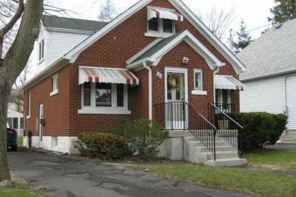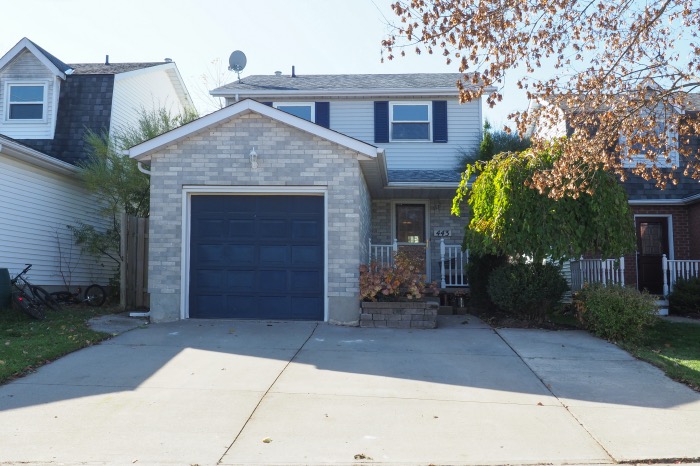I recently sat down for a Q&A session with a home inspector I know (Tyler from 360 Inspections) and discussed home inspections. I asked him to take me through the home inspection process and point out the questions he asks and and finds answers to when preforming a inspection.
Q: How much do home inspections cost?
A: Home inspections usually cost $400-$500, (a little less for condos).
Q: How’s the grading?
A: The grading around the home is important because it is one of the last defenses against the possibility of water entering the foundation causing damage to the structure and/or furnishings. The grading should slope away from the foundation aiding in the drainage of water out and away from the structure. If the grading slopes towards the foundation, it is definitely not helping your home defend itself against the elements. This could lead to damp or wet crawlspaces, foundation movement, cracking or settlement. Water leaking in through the foundation could lead to rot in the walls, framing members and mold.
Q: How’s the roof?
A: The roofing material is the primary defense mechanism against the elements. As the roofing material ages, it needs to be inspected more regularly to ensure that it stays in good condition and it’s performance isn’t compromised. Issues with the roofing material can lead to expensive repairs or even worse, replacement. Asphalt shingles have a life expectancy of between 12-20 years; however if improperly installed this is drastically reduced. Asphalt roof shingles will begin to cup, blister and have granular loss making water intrusion a big concern.
Q: How are the gutters and downspouts?
A: The gutters and downspouts of a home protect the building’s exterior from water running off of the roof by discharging the water away from the siding and the foundation. This ensures that your home will have a dry basement and that the siding will stay intact. gutters and downspouts can be made of several different materials such as galvanized steel, plastic, and the most common being aluminum. The most common issues with any gutter and downspout system is leaks. Most joints and seams will begin to leak with age; however in most case they can easily be repaired by a professional at a reasonable price. Leaks can do damage to walls, soffits, fascias, cause water intrusion issues into your basement, and in the winter can cause unwanted ice patches on steps, walkways and driveways making for unsafe conditions. So monitoring your gutters and downspouts on a regular basis is strongly advised. Other issues with gutters and downspouts include clogged, downspout discharge, discharging onto the lower roof in multi-storey applications and missing downspout extensions.
A home inspection will ensure that your gutters and downspouts are fully inspected. The type of material will be identified, the most common being aluminum. Aluminum gutters and downspouts have a life expectancy of 20 years; however if improperly installed or abused this is drastically reduced. Gutters and downspouts suffer a lot of abuse from ladders, tree limbs, ice/snow, leaves, etc. Also improper installation causing them to become loose by heavy snow/ice build-up could lead to a severely shorter life expectancy and even worse – damage to walls, soffits, fascias, and especially wet basements.
Q: How’s the siding?
A: The materials protecting the outside walls of your home are referred to as your siding. These materials could consist of brick, stone, stucco, wood, metal, and vinyl. The siding protects the structure and interior from weather and mechanical damage. There are numerous things to check in regards to the siding depending on the type of materials used. For brick, this includes cracking, missing mortar between joints, spalling and efflorescence, all which could possibly hint to some sort of structural issues. For stucco, checking for cracking, bulges, or loose material is common practice. Wood siding issues include, splitting, wood/soil contact, paint or stain issues, and cracking. Metal siding is very durable so most issues are in regards to the installation of the Siding as opposed to the condition itself. A few conditions to check would be dents in the siding from object striking it, or buckling. The most common siding is vinyl siding, it is the most common due to the fact that it is extremely durable and like metal siding most issues occur due to improper installation, not damage to the siding itself. Common problems with Vinyl Siding are similar to Metal as well, these include, tearing, burned, buckling, or cracking.
Vinyl siding has a life expectancy of over 50 years; however if improperly installed this is drastically reduced. A lack of proper securing, and improper finishing at edges and corners are the most common deficiencies.
Q: How is the foundation?
A: The foundation is a very important part of your home. It is what the entire structure relies on for support, and in order for your home to be a safe place to live, your foundation needs to be kept in good condition. Common problems with the foundation range from weathering issues such as small cracks and spalling and settlement to major structural and water infiltration issues such as large cracks and bowing of foundation walls. Most common problems with leaks and weathering of the foundation can be solved by correcting issues with the grading and improper discharging of water from the downspouts and gutters. Severe cracking and bowing of the foundation can point to structural issues which should be further inspected by a structural engineer.
 Every 360 INSPECTION SERVICES Home Inspection will ensure that your Foundation is fully inspected. Any cracks, spalling, or settlement issues will be identified and reported. Improper or inefficient lot grading and improper discharging of gutters and downspouts are the most common problems associated with damage and water intrusion of the foundation.
Every 360 INSPECTION SERVICES Home Inspection will ensure that your Foundation is fully inspected. Any cracks, spalling, or settlement issues will be identified and reported. Improper or inefficient lot grading and improper discharging of gutters and downspouts are the most common problems associated with damage and water intrusion of the foundation.
Q: How are the doors and windows?
A: As you would imagine the doors and windows of your home are important for a few reasons. They protect you from the elements, and also keep you safe. Things to look for when inspecting the doors in the home are functionality, condition, integrity, proper installation and proper materials. The front door should be constructed of either solid wood, or insulated steel. If there is an access door between the garage and interior, that door should be a fire-rated and insulated steel door with a automatic closing device to keep the door form accidentally being left open. Other doors leading into the home should be of the same materials listed above to keep your home safe and energy efficient. It is always recommended to install an insulated steel garage door as well to keep your home warmer and more energy efficient, especially during the winter months. When looking at the windows of the home it is always good practice to first determine how efficient they are. If the home you are looking to purchase is 50+ years of age then the windows are most likely not going to be the most energy efficient. Windows are very important for protecting you from the elements, but they are also very important for keeping your home warm during the winter months. They should not be cracked, or have water build-up between the panes if they are a double or triple-pane type. Condensation is another issue; however most times it can be repaired at a reasonable cost without having to replace the entire window.
Steel exterior doors have an average life expectancy of 50+ years. Vinyl-trimmed, double-pane windows have an average life expectancy of 20-40 years. Improper installation of doors and windows are a major cause of a drastically shortened life expectancy.
Q: How is the electrical system?
A: Electrical components in your home are everywhere, which is why this is such an important system to take the time to analyze very carefully. When trying to ensure that the electrical system is in good condition an important component to look at is the service panel. If there is some wiring in the home that was installed improperly or new renovations such as a finished basement, chances are you’ll find out if it was done incorrectly by examining the service panel. Common issues with the service panel are a missing or damaged cover, unprotected panel openings, poor location, crowded wiring, improper wiring, overheated, poorly secured wiring, and other issues such as rust or even worse water inside the panel. All of these issues are a safety hazard and should be addressed by a licensed electrician. Wiring inside the home is somewhat harder to assess as most of it is behind walls, but some areas where you can get glimpses would be an unfinished basement or a finished basement with an unfinished storage area or furnace room. These areas will allow you to be able to see how the wiring was installed, whether properly by a professional or improperly by a do-it-yourselfer with wires hanging from joists, improperly fastened to studs, bad connections, etc. etc. Other issues occur when the home was built before the mid 1980’s and there are issues with Aluminum wiring, or when the home was built before the 1940’s and you run into Knob and Tube.
Improper installation of electrical components are a major cause of safety issues and compromise the integrity of the entire system.
Q: How’s the plumbing?
A: Plumbing issues are similar to electrical issues in the sense that when installed properly they will last a very long time, but when installed improperly they do not function the way they should, the are a safety concern and even more they could potentially cause damages to your interior if they were to break and leak. The plumbing system is generally easy to inspect in terms of determining what has been installed properly or not. Common issues with improperly installed plumbing piping and components are low water pressure, leaks, damage, sloppy workmanship, noise, inadequate hangers, etc. All of this is relatively easy to spot and if noticed should be inspected further by a licensed plumber. Other issues with plumbing systems if looking at an older home built prior to the mid 1950`s is galvanized steel piping. This piping if found today should be replaced due to the fact that it is most likely at the end of its service life, build-up of calcium and other mineral deposits inside the piping over the years can greatly reduce the water quality and flow.
Improper installation of plumbing components are a major cause of water leakage issues, improper functionality and compromise the integrity of the entire system.
Q: How are the heating and cooling systems?
A: The heating and cooling systems of a home are difficult to sum up into just one section. Inspecting these components takes a trained eye due to the complexity and variation of these systems in general. The heating system of a home has changed vastly over the years and is somewhat complex. The various fuel types for Heating systems over the years includes steam, electric, propane, wood and gas. The most common in major cities these days is natural gas. Cooling systems are generally a unit installed outside the home with lines leading into the Furnace feeding cold air throughout the home. Key items to check would be the furnace filter, which should be replaced every 30-days to keep the air in your home clean. The lines leading from the air conditioning unit into the home should have the insulation intact. The burners inside the furnace should all light up and be the appropriate color, for gas this is a bright blue. There should be no rust inside the furnace which would hint at the possibility of ventilation issues.
The life expectancy of a high-efficiency gas furnace is 15-20 years. The life expectancy of a central A/C unit is 10-15 years. Improper maintenance of the heating and cooling systems are a major cause of shortened life spans, which is why it is advised that you have your system inspected annually by a licensed HVAC technician.
Q: How is the insulation and ventilation?
A: Insulation and ventilation in your home is a huge factor for how comfortable your home is and how efficiently you are able to heat and cool it. A properly insulated home will keep you warm in the winter and cool in the summer. A big factor with how you are able to keep your home efficient is handling the way air moves in and out of your home, the more air moves in and out the less efficient your home will be. The attic is a very good place to check for how well your home is Insulated and how well it can vent the unwanted air out. If the ventilation in your home isn’t that great there will be obvious signs in the attic such as mold spots or damp spots from condensation. If your home is improperly insulated the bottom of your roof will show the same signs also, especially if you examine your attic in the winter months and the roofing nails used to hold your shingles on are frosty and in some cases even growing mini-icicles. Improper insulation and ventilation are a major cause of mold issues and compromise the integrity of the entire system.
For more information please visit website.






